- Submissions

Full Text
COJ Robotics & Artificial Intelligence
Implementation of Competencies by Smart Ethical Artificial Intelligence in Different Environments
Bryndin E*
Department of Research, Russia
*Corresponding author: Bryndin E, Department of Research, Russia
Submission: March 26, 2021;Published: April 29, 2021

ISSN:2832-4463 Volume1 Issue4
Abstract
Smart artificial intelligence has psychological, analytical, research, language, professional and behavioral competencies. Its psychological competencies are communication, self-regulation, adaptability during changes, motivation, empathy - identifying the needs of the environment. Psychological competence determines his psychological intelligence - the ability to adequately use his own capabilities, the ability to find solutions and choose adequate ways of communication. Ethical competencies of intelligent artificial intelligence are determined by ethical standards. Each competence is exercised by an intelligent agent with a competent functional professional manner. Intelligent agents form an ensemble with intelligent ethical artificial intelligence. The use of an ensemble with smart ethical artificial intelligence in various environments is carried out by synergistic tuning of the interaction of intelligent agents based on data of specific environment obtained by an analytical competent intellectual agent. The interaction of the analytical competent intellectual agent with the environment is carried out through the smart interface of the ensemble.
Keywords: Competencies; Environment; Functional image; Intelligent agents; Smart ethical artificial intelligence
Introduction
In various areas of life, systems with artificial intelligence with analytical and communication competencies are used. Chat bots with analytical and communication competencies based on artificial intelligence are able to conduct a dialogue with a candidate for work and further evaluate its potential effectiveness. The chat bot is able to interpret the applicant’s indirect response. A newly arrived employee can ask a bot about the schedule, company structure, benefits and other issues important in the first months of work. Chat bots are developed by Mya Systems, Paradox, Text Recruit. In Russia - Robot Vera and Yandex. Talents. By analyzing data using artificial intelligence, you can find an action that is really related to efficiency in a particular company and form a really working competency model. DEEP allowed, on the basis of HR analytics, to form a universal competency model for Russian companies. Artificial intelligence systems with analytical and communication competencies are also used to assess the effectiveness of training. The link between learning and improving performance is analyzed.
Today, more and more enterprises are using IBM Watson’s truly unique technology platform and cognitive cloud services to solve their business problems. One of Watson’s most striking possibilities is to build and evaluate hypotheses: the system uses advanced analysis tools to compare and evaluate groups of responses based on only significant facts. Watson also supports dynamic learning - during the process, the system learns itself, which allows it to improve results with each iteration, while becoming smarter and smarter. The IBM Watson platform is unique both in depth of capabilities and in the coverage of already known applications. Customizable enterprise solutions are combined into a common portfolio of IBM Cloud Business Solutions. Its users are provided not only with cloud applications, but also with cloud infrastructure, as well as consulting, analytics and technical support services. In the portfolio of IBM Cloud Business Solutions there are both horizontal solutions - in particular, for marketing, finance, personnel management, operations management, and vertical ones - for customers from the financial sector, transport industry, healthcare, telecommunications companies, electronics manufacturers, consumer goods, retail networks.
This is the time when cognitive computing steps in to facilitate and back these daily interactions. The demand for cognitive computing services has been projected to skyrocket. According to Grand View Research, the global market is expected to reach $49.36 billion by 2025. These theoretical predictions are not the only proof of the success that cognitive computing promises. According to a survey of early adopters conducted by IBM Cognitive, companies that have embraced the capabilities of cognitive computing have already noticed considerable return on their investment: 65% of respondents said the technology became crucial to the overall success of the business; 58% said it was pivotal in the companywide digital transformation; and 58% said it would remain an important competitive advantage in the future.
At its core, cognitive computing implies the use of computer models and algorithms to replicate how humans think and reason in complex situations where the answers aren’t simple and straightforward. Cognitive computing systems combine information from a wide variety of sources and evaluate the context in order to find their way to the best answers possible. In this process of data synthesis and evaluation, the systems rely on data mining, pattern recognition and natural language processing to simulate the thought process of a human brain.
With the systems’ extensive reliance on structured and unstructured data, the technology requires large amounts of such information to tackle more complex problems usually left to human judgment and reasoning. The data is fed to the machine learning algorithms that identify patterns and gradually learn to predict problems and design solutions in a faster, more efficient manner. As a next-generation solution that’s already a reality, cognitive computing stands out with a number of attributes that make it a viable investment for businesses undergoing a digital transformation and seeking more growth, engagement and productivity.
Cognitive systems are at their core, highly adaptive, quickly adjusting to the digital transformation strategy of the company as it evolves and changes over time. This flexibility and agility also ensure that the systems are able to read and process information in real-time and are immune to the adjustments and changes to the data as it is fed into the machine. A critical component of cognitive computing is human-computer interaction. As the needs of the users evolve and change, the system adjusts to these changes, constantly preserving the ability to recognize and meet those needs in the best possible way - something that the inherent agility of the system makes possible.
A similarity between human reasoning and cognitive computing is how cognitive systems - just like human brains - are able to quickly identify uncertainty and incompleteness, thus asking the right questions or engaging more data to find optimal solutions. One method to approach this is to survey similar situations that have enough information on how to resolve a similar problem. The pattern identification abilities of cognitive computing make it possible for the technology to work its way through vague problems and find definitive solutions through data surveying, pattern recognition and asking the right questions when needed.
Finally, what makes cognitive computing so unique is its ability to understand the context in which the problem occurs. Cognitive systems are able to understand and identify such contextual information as syntax, time, location, domain, requirements, a user’s profile, tasks or goals. The sources for this type of information are both structured and unstructured data, ranging from visual to sensory and even audio.
One important question that usually arises is in regard to the major overlap between cognitive computing and artificial intelligence. While both, indeed, share a large number of capabilities - and AI is the larger umbrella term for such smart technology - there is a key distinction between the two advanced systems. And it’s in the purpose and goals of the technology.
Cognitive computing and AI both include many of the same underlying technologies, such as expert systems, neural networks, robotics and virtual reality (VR). AI technologies largely imply the combination of such technology as machine learning, neural networks, NLP and deep learning. Some of the more prevalent applications of AI technology are intelligent assistants - like Alexa, Siri or Google Assistant - and autonomous vehicles. Typically, AI is trained on data over a period of time to teach the system the ability to learn certain variables and eventually predict outcomes.
When it comes to cognitive computing, the term usually refers to AI solutions that replicate the human thought process. Just like the human brain analyses the environment and understands the larger context it operates in, cognitive computing approaches the task of solving problems in the same way. The types of technology that make this simulation possible are machine learning, deep learning, sentiment analysis, neural networks and NLP.
To put it into the context of business applications, the goal of an AI system is to automate internal processes and reach maximum efficiency and productivity within the organization. In contrast, cognitive systems are tools designed to help humans - such as employees or company leaders or even customers - make better-informed decisions. A perfect example of the support that cognitive systems offer to human professionals is IBM Watson for Oncology. Used by professionals focusing on cancer treatments, the technology has made it possible to augment the medical professionals’ experience in identifying the best solutions for patients by generating a wide range of hypotheses and suggesting various treatments for the doctors to discuss and prescribe.
Cognitive computing is a subcategory of AI that comes closest to mimicking human cognition - and in that, it opens numerous doors for companies to improve customer engagement, internal efficiency and maximize growth. The technology’s intent is, indeed, slightly different from the traditional promise of AI technology - but in that difference, cognitive computing puts emphasis on augmenting human capabilities and helping professionals perform better, rather than acting as a replacement for human skills. The article considers the implementation of analytical, psychological, research, language, professional and behavioral competencies of smart ethical artificial intelligence in various environments [1-4].
Requirements of Competencies of Smart Ethical Artificial Intelligence
Smart artificial intelligence has psychological, analytical, research, language, professional and behavioral competencies. Its psychological competencies are communication, self-regulation, adaptability during changes, motivation, empathy. Competencies are defined by a set of requirements. Psychological competencies are determined by a model with psychological requirements. Psychological requirements are functional states of the system. Psychological requirements are states that play an appropriate role in the functional organization of the system. Each state is independent in communications. Adaptation is the state of optimal system operation in a variable environment. Empathy is a functional identification of the needs of the environment. The psychological competencies of intelligent ethical artificial intelligence are functional in terms of conceptual apparatus and methods.
The research competence of artificial intelligence requires learning and gaining new knowledge of the proposed problem, working with various sources of knowledge, investigating proposed topics, conducting experimental observations, proposing ways to solve the proposed problem and looking for the most rational solutions to proposed projects. Research competencies develop in the course of research activities according to the model of their formation. For example, the formation and development of research competencies for project activities. The development of research competencies is carried out on the basis of key competencies. Key competencies are various universal tools and tools, formalized methods, methods and techniques such as comparison, analysis, systematization, generalization, classification, causation, etc. Key competencies allow you to achieve results in uncertain, problematic situations. They allow you to independently and in cooperation with a specialist to solve problems, that is, to cope with situations for which there is never a complete set of available funds. Key competencies are interdisciplinary, manifested in various areas. Their availability is necessary for productive research, building communications with the environment.
Linguistic ethical competencies are based on a system of stable communication formulas prescribed by society to establish speech contact of interlocutors, maintain communication in a chosen tone, respectively, their social roles and role positions relative to each other, and mutual relations in an official and unofficial setting. Business etiquette has become increasingly common in the business community, especially recently. Business etiquette provides for compliance with standards of behavior and communication. Since communication is a process, communication primarily takes into account the features of speech etiquette. Speech etiquette refers to the developed rules of speech behavior, a system of speech formulas of communication. The degree of proficiency in speech etiquette determines the degree of profitability. Knowledge of business etiquette is the key to success in achieving the goal. The ethics of business communication is associated with the manifestation of morality and morality in business communication, business communications.
Communicative ethical competencies are a component of culture. Its core is values and principles, which are implemented in some norms and rules. Rules and regulations are specific recommendations, regulations on communications. It is important to follow these rules and regulations in business communications. The ethics of business communications is a set of moral norms, rules and ideas governing relations in the process of their production activities. The ethics of business communications should be taken into account in its various manifestations: in the relationship between the enterprise and the social environment, between enterprises and within the same enterprise.
Analytical competencies define the requirements to turn ad hoc improvements into systematic key performance indicators through information analysis. This requires knowledge and activity data, strong data management skills, excellent statistical skills, and the ability to assess the positive and negative aspects of the proposed actions. Analytical competencies involve a consistent analysis of data and situations in order to see the cause and effect and use this to make effective decisions. Situation is laid out into components (A,B,C). List items, tasks or activities without setting priorities. Review data and identify key priorities. Determines the cause and effect of “if A..., then B.” and use this to prioritize. They analyze complex situations, considering several possible causes and consequences. They conduct a comprehensive analysis of complex data, and by solving complex situations, they track the impact of solutions on efficiency and quality of work.
Comprehensive Implementation of the Competencies of Smart Ethical Artificial Intelligence
The complex implementation of the competencies of smart ethical artificial intelligence is carried out by an ensemble of intellectual agents with competent professional images [4-6]. Professional images of intellectual agents indicate belonging to a certain profession. Professional images are a cognitive component of intelligent agents. Meaningful components of professional images are labor functions, subject and goals of activity, process and results of professional activity, criteria for assessing achievements, norms, rules and reference model of profession. Professional images include an owl of evaluation characteristics and associated behavioral actions. The component composition of the professional image is mainly the unity of three components: cognitive, affective assessment and behavioral adaptation.
In the process of educational and professional activity, the intellectual agent acquires the skills of the future profession through the inclusion of the environment and conditions of professional activity. The manifestation of an intellectual agent as a subject of labor is revealed most fully in achieving a professional position that integrates professional situations, communications and a professional image, which characterizes his identity, certainty and integrity. The profession acts as a socio-objective component of the professional continuum of intellectual agent activity, professional readiness arises as a formal reality, and professional identity as an informal, semantic, subjective reality. From this perspective, profession and professional identity are linked by causal dependence as a cause and consequence.
Ensembles of intellectual agents with professional images will allow him to have various required professions and competencies through diversification and mobility. An intelligent ensemble is a complex of compatible intelligent agents interacting through an intelligent interface, implementing either technological process, social services, multidisciplinary interdisciplinary research, or a production cycle. Diversification extends the functions of the intellectual ensemble and its development of a new type of functionality in order to increase efficiency, quality and its functional diversity. Mobility contributes to the rapid functional retraining of intellectual agents and the development of professional intelligence of the ensemble. Diversification and mobility will align the life cycle of intelligent agents as a common benchmark for linking them to the environment. The environment is perceived through images and scenes. Scenes consist of a number of images. Scenes are static (paintings) and dynamic. Dynamic scenes are characterized by patterns of behavior of objects and objects. The patterns are either described by formulas or presented in a graph (numerical way). Ethical activity is ensured within the boundaries of the similarity of images in the environment. The ethical activity of intellectual agents depends on spatial, temporal, substantive, visual and sound sensitivity, the ability to acquire, process, apply and diversify knowledge based on previous experience in solving specific problems related to the processing of data attributes and the mobility of the intellectual ensemble.
Functional Modeling of Communication with Environment
The environment state is set to S = {s1,s2,... } environment states. At any given moment, the environment is in one of these states. The agent’s ability to act is represented as set of actions A = {a1,a2,...}.
The interaction of the agent with the medium is described functionally as a sequence of medium states on actions. Such an agent decides what action to perform based on experience, that is, his own experience gained to date. This experience is presented as a sequence of environment states in which the agent managed to visit. If the result of performing an action in any state is unique, then the environment is deterministic, and its dynamics can be accurately predicted. Let us present the experience of interaction of the agent with the medium as a sequence of state-action pairs:

Where s0 is an initial condition of the environment
au - action which was chosen for performance by the agent is able su, which is possible result action performance the a u−X in condition sw_j. We will enter functionality see, which defines ability of the agent to watch the environment, and the function action, which represents process of decision-making by the agent the functionality see is implemented hardware in case the agent is in the physical world. In a virtual environment the functionality see is implemented by system teams which analyze information on a virtual environment. An exit of functionality see is percept perception. The functionality see connects state of environment and their perception percept by data attributes. Through the function action the sequence of perceptions and action communicates by data attributes.
Attributes of data: objects, objects, materials, things, processes, the phenomena and other aspects of the physical world have various properties and characteristics. Properties are represented by qualitative attributes. Characteristics appear to be meaningful attributes. The qualitative attribute can be visual or sound. The meaningful attribute may be represented by a number, a language sense, a visual or sound image, a mathematical or behavioral action, or an algorithm. Meaningful qualitative attributes are big data of smart artificial intelligence, connected in time, space and subject area. The attributes of the fields of economics, industrial industries, technologies and professions help to build and train the ensembles of intelligent agents to manage, make decisions and make recommendations to specialists and managers.
Smart artificial intelligence, possessing psychological (selfregulation, adaptability motivation and empathy), analytical, research, language, professional and behavioral competencies help intellectual agents adequately perceive various states of different environments and take correct effective actions. Functional environment modeling allows you to study environmental states by intelligent agents based on empathy and adaptation to the environment by smart artificial intelligence and identify optimal connections of perceptions and actions.
Adaptation is the process of changing the parameters and structure of an ensemble of intelligent agents, and possibly control influences, based on current information about the states of a new environment in order to achieve communication with it. The empathy of smart artificial intelligence allows you to recognize and control the states of the environment. Empathy is accomplished by perceiving the environment. Perception (understanding) is formed by observation (study) of the environment. The result of studies of environmental states is a concrete rational solution. Adaptive intelligence, combining skills for quick and comfortable adaptation to new conditions, helps make the right decision. Adaptive intelligence allows you to not only adapt quickly and act in unforeseen circumstances, but also create changes in parameters and structure and start processes that lead to positive solutions [1].
Parametric adaptation is associated with correction, adjustment of ensemble parameters. The need for such adaptation arises due to drift in environmental characteristics. Adaptation allows you to adjust the ensemble at each step of observation, moreover, the initial information for it is the mismatch of responses of the environment and the ensemble, the elimination of which implements the adaptation process. When the structure of the environment changes, there is an inadequacy of communication between the ensemble and the environment. Then the adaptive system responds to changes, explores the new structure of the environment. Finding itself in a new environment, it builds similar and similar communications based on new structure data, an adaptable system is alternatively and compositionally adapted to perform its functions in a new environment in the best possible way. Parametric adaptation is also performed automatically.
Functional environment modeling helps to accumulate attributes in real time and at the same time use them for deep training of multilayer artificial neural networks of intelligent agents for making decisions and making recommendations. Modeling determines the environment and perception states of intelligent agents and the limits of the attributes of professional images. Perceptions of intelligent agents within the values of the attributes of professional images contribute to their ethical communications with various environments.
Communications of Robotic Intelligent Agents with the Environment
Interaction with the environment of ensembles of intelligent agents with professional images is carried out through digital doubles, cognitive robots. Recently, the world has become interested in robotization in the service sector. Night tours of the London Tate gallery were driven by robots. Rather, only humanoids moved around the halls of the museum, and viewers could consider works of art and listen to the explanations of smart guides on the screens of computers. We went even further in South Korea. At the Daegu National Museum, robots collect entire groups of excursionists and conduct them on permanent display. The wide use of intellectual agent ensembles with intelligent ethical artificial intelligence is carried out on the basis of an ethical standard, so that their use does not harm or harm.
Ethical standard for the use of intelligent agent ensembles
The wide use of intellectual agent ensembles with smart artificial intelligence is carried out on the basis of an ethical standard, so that their use does not harm or harm [3]. Ensembles of agents with artificial intelligence are multi-agent synergistic self-organizing systems that function according to the laws of development, synergy and self-organization. Intelligent agents use physical, informal and logical model of the environment. That is, they use both attributes and sets of entities, processes, relationships, etc. Standard case Application of ensemble of intelligent agents defines parameters, characteristics, methods, human digital double models, knowledge, skills, behavior, images, and other entities of intelligent virtual agent interaction (Table 1-7). Intelligent virtual agent interaction uses categorical method of utility and preference [1]. Standard case “Application of ensemble of intelligent agents” contributes to the formation of an ethical digital environment with smart artificial intelligence. The synergistic mechanisms of selforganization of technological ensembles of intelligent agents are basic for standardization in the application of ensembles in various fields. Communicative-associative smart artificial intelligence with the help of an ensemble of diversified agents with a smart interface help control ethical application of ensemble intelligent agents [4].
The standard case «Ethical application of ensemble intelligent agents» contains seven tables.
Table 1: General.
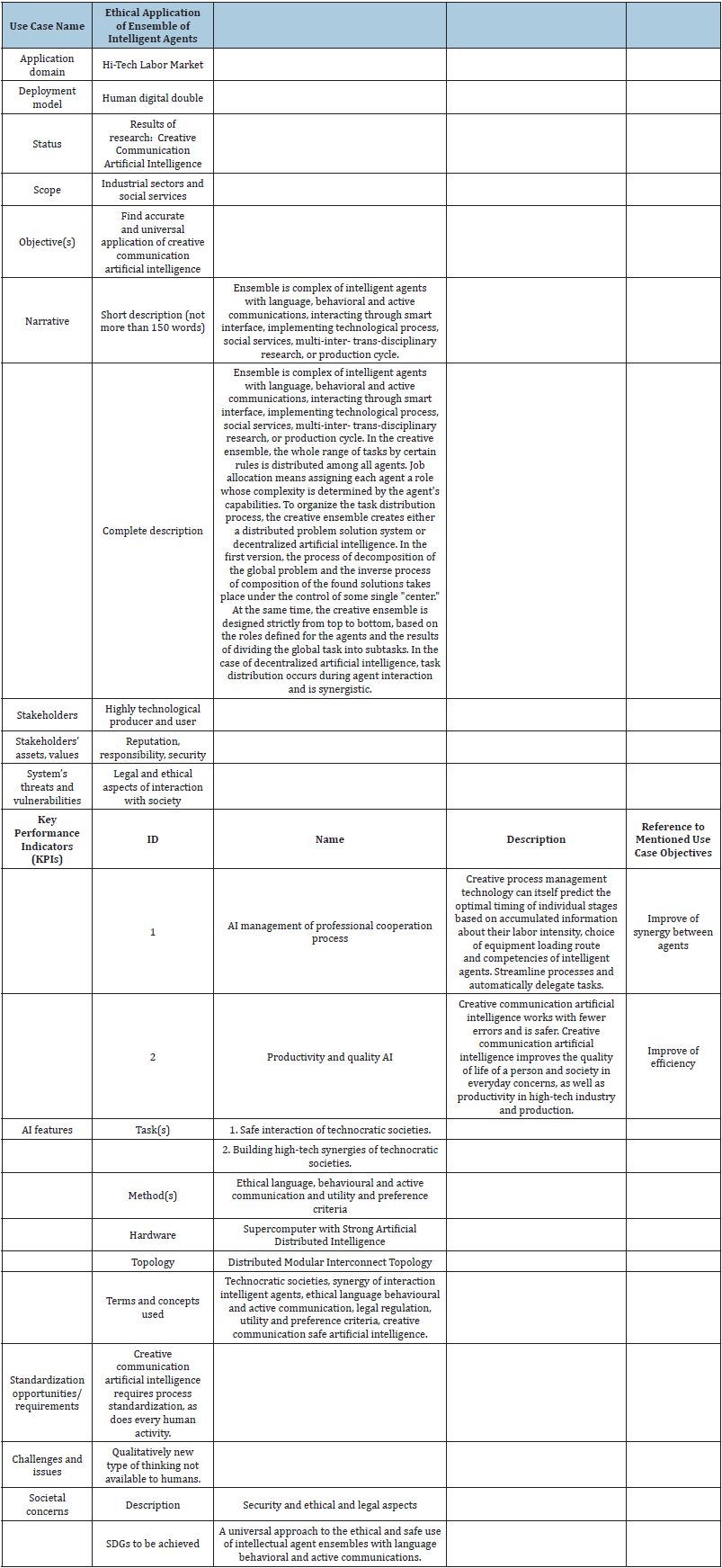
Table 2: Data.

Table 3: Process scenario.
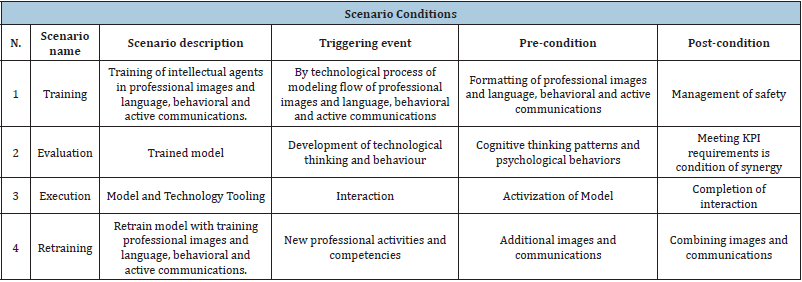
Table 4: Training
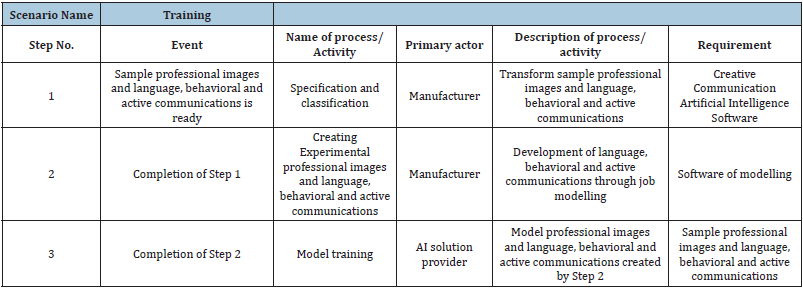
Table 5: Evaluation.
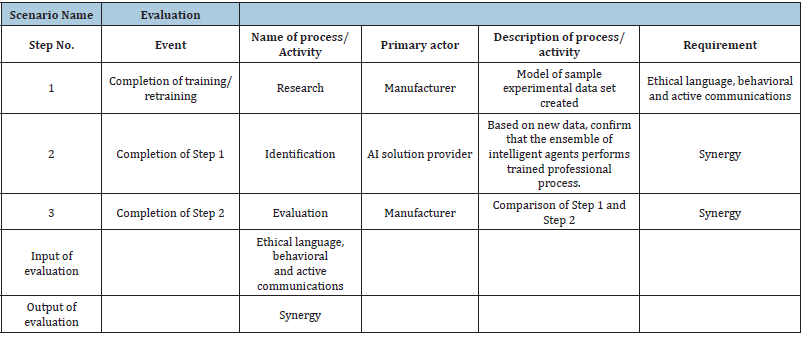
Table 6: Execution.
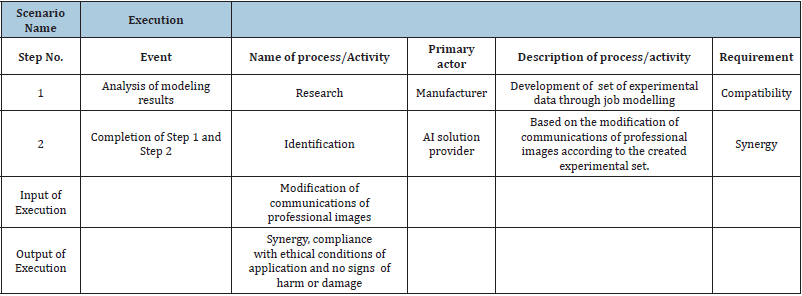
Table 7: Retraining.

Ethical standard improves safety of application of robotic systems with smart agent ensembles. Robots have already tried on the aprons of waiters, stood at the racks in hotels and settled in stores, galleries and airports. More and more high-tech robotic cognitive systems are emerging [7-15]. In the social service sector, robots occupy more and more jobs.
Automated shop and cafe
A smart robot begins to issue goods and products in the store with imitative thinking and adaptive behavior through machines (Figure 1). The robot communicates with customers through an order receiving system. The buyer through the electronic money reader is calculated by a plastic card. The buyer informs the robot of the list of goods and products the order. The robot, through the receiving system and the software multidisciplinary controller, activates trays of goods and products according to the order. The customer inserts the plastic card into the electronic money reader. When the order is formed by the machine, the robot reads the electronic money from the plastic card of the customer, at the prices of the goods. The buyer receives a set of goods the order from the machine and picks up a settlement plastic card.
Figure 1: Robotization of Service.

The smart robot controls behavior through a multifunctional hierarchical system of controllers. Behavior occurs under the influence of the need of the visitor, which causes orientation in the situation according to models of the environment and behavior. The orientation is completed by selecting the appropriate program of the hierarchical controller system, the execution of which leads to the implementation of the behavior. The robot has devices for interacting with the environment. They receive information from the environment through sensors: phototransistor, microphone, contact sensor [15].
A hierarchical approach allows you to formalize the requirements for mobility of robot behavior and develop all possible algorithms for responding to changes in the state of the environment. For example, when moving on the street, using satellite navigation technology, and surrounding objects, detecting using cameras, rangefinders and spectroscopic vision. That is, the approach allows autonomous robotic systems to be designed for the implementation of many social spheres of life.
The smart cognitive architecture of the robot, using the criterion for improving functional activity, is capable of recurring self-improvement. Cognitive architecture includes artificial neural networks, machine learning algorithms, the smart big data cognitive system, and a high-quality selection system. The smart cognitive architecture of the robot determines step by step how best to achieve the given goals and realize preferences through the actions of the utility function based on high-quality selection. Self-improvement is carried out by machine retraining according to the preference criterion on the basis of extensive statistics of highquality selection of skills and competencies. Intelligent cognitive architecture of robot strives for development by machine retraining based on accumulated professional and behavioral skills [16].
The use of robots in an automated store does not require registrations, code scans and other manipulations. All that is necessary to make purchases is to install the application on smartphone. After that, you can safely go to the store, choose goods, fold them as convenient and were convenient. Everything - after taking the necessary, the customer simply leaves the store, without visiting special zones, frames, or scanners. Money is automatically debited from the card, and the receipt instantly comes to the owner’s smartphone.
But, of course, in reality, not everything is as rosy as in theory and advertising. Already on the first day of work, it turned out that artificial intelligence could count customers by counting them goods that they decided not to take; does not always recognize theft and may not take into account the purchase if the visitor takes the goods too quickly. The store’s artificial intelligence system uses the required number of cameras and special algorithms. They record the speed, movement, gaze and pitch length of visitors to understand exactly what the buyer is going to take, as well as to calculate a potential thief. At the same time, they do not collect and store biometric data of customers. Microsoft has developed a universal intelligent system that will allow companies to independently open automated supermarkets without personnel. Through the introduction of modern deep learning methods, they improved the experience of retail. Getting rid of slow, bulky lines of machine sales.
Electronic stores with multi-agent systems appear [5]. An electronic multi-agent store is a community of electronic store agents (sellers, managers, cashiers, security) and customers who can communicate and exchange information through electronic means of communication in the absence (or minimum) of personal direct contact. A store virtual agent is a representative office implemented by creating a Web server on the Internet to sell goods and services to other users of the Internet. He must provide the customer with information about the goods (service) and receive an order for the goods (service) from the customer. The cashier agent receives payment when using online payment systems. The agent manager will ship the paid item if the buyer does not pick up the item himself. The robot agent consultant greets customers in the store, helps them find a specific product on the entire sales window, and answers general questions. An electronic agent security guard monitors store customer through a review system. In case of violation, he blocks the door until the police arrive, which serves the store.
A robot consultant appeared in the Tokyo department store Mitsukoshi in April 2015. Outwardly, the humanoid, developed by Toshiba, looks like a real girl: dark hair, light skin, a pink jacket for the color of lipstick. In addition, she knows how to nod, move her lips and talk. True, only in Japanese. The robot was given the name Aiko Chihira. By contacting the consultant, you can find out about available goods, special promotions and sales. Robot waiters are introduced in restaurants around the world. Artificial intelligence serves visitors at Bangkok’s Hajime Robot Restaurant. A humanoid with a height of a person, dressed in national armor, is separated from the guests of the institution by a glass partition. On the tables in the restaurant hall there are tablets on which customers order. He goes to the robot, which collects dishes on a tray and takes it to visitors. Along the way, he sings songs and winks friendly.
Robotic hotels
In mid-July 2015, the first hotel opened in Japan, a significant part of whose employees are robots (Figure 2). In a hotel called Henn-na in Nagasaki Prefecture, four humanoid doormen, three receptionists, two maids and one dressmaker carry watch. The rest of the employees are living people, but gradually they will yield jobs to robots. Humanoids from the Henn-na Hotel were developed by Koroko. Engineers gave them a human appearance. So, inanimate reception employees look like cute young Japanese women. They know how to breathe, blink and make eye contact. And they speak four languages: English, Japanese, Chinese and Korean.
Figure 2: Japanese robotic hotel.
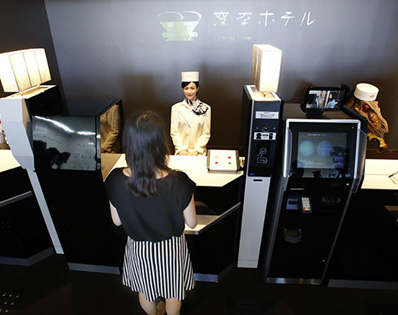
In addition to service personnel with artificial intelligence, the hotel is “stuffed” with numerous high-tech devices. For example, a facial recognition system works at the entrance to the rooms, so someone else will definitely not pass. And in the rooms themselves there is a system for determining the body temperature of people, knowing which you can set the desired degree in the room. Living among robots is a pleasure quite affordable. The cost of a night in the hotel starts from $60 for a single room and reaches $150 per room for three. In the Hotel Aloft in American Cupertino, a robot employee appeared even earlier than in the Japanese hotel Henn-na. A humanoid named Botlr joined the butler service in the summer of 2014. Outwardly, it resembles a R2R2 robot from Star Wars. Botlr is able to travel along the corridors of the hotel at a speed of up to 6 km/h and not collide with guests or luggage. The robot will fulfill any customer wishes. For example, deliver a sandwich, fresh towel or new toothbrush to the room.
Conclusion
Smart ethical artificial intelligence with analytical, research, psychological, linguistic, professional and behavioral competencies approach human intelligence. Its psychological competencies (communication, self-regulation, adaptability during changes, motivation, empathy - identifying the needs of the environment) allow you to fully interact with a person in many areas of life. The analytical and research capabilities of smart ethical artificial intelligence and the ability to process big data can help solve the pressing problems of mankind with powerful supercomputers. The creation of cognitive robotic multi-agent systems with intelligent ethical artificial intelligence requires the development of tools, new criteria, methods, functional approaches, and interdisciplinary model of hybrid intelligence to ensure synergy of its competencies in different environments. The interdisciplinary direction of “hybrid smart ethical intellectual systems” will bring together scientists and specialists investigating the applicability of several competencies from various specialties and will attract them to create smart cognitive robots to solve complex problems in environments inaccessible to humans. Cognitive smart robots with hybrid intelligent ethical artificial intelligence will be able to perform a large number of various tasks that humanity poses.
References
- Bryndin E (2020) Communicative-associative development of smart artificial intelligence by criteria with the help of ensembles of diversified agents. International Journal of Intelligent Information Systems 9(4): 24-34.
- Bryndin E (2020) Formation of technological cognitive reason with artificial intelligence in virtual space. Britain International of Exact Sciences Journal 2(2): 450-461.
- Bryndin E (2020) Creative communication safe ethical artificial intelligence in the era of technological development. Software Engineering 8(3): 13-23.
- Bryndin E (2021) Formation of international ethical digital environment with smart artificial intelligence. Automation, Control and Intelligent Systems 9(1): 27-38.
- Bryndin E (2019) Collaboration of intelligent interoperable agents via smart interface. International Journal on Data Science and Technology 5(4): 66-72.
- Bryndin E (2020) Technology self-organizing ensembles of intelligent agents with collective synergetic interaction. Automation, Control and Intelligent Systems 8(4): 29-37.
- Bryndin E (2019) Collaboration Robots with Artificial Intelligence (AI) as digital doubles of person for communication in public life and space. Budapest International Research in Exact Sciences 1(4): 1-11.
- Bryndin E (2019) Robots with artificial intelligence and spectroscopic sight in hi-tech labor market. International Journal of Systems Science and Applied Mathematics 4(3): 31-37.
- Baneree S (2018) A framework for designing compassionate and ethical artificial intelligence and artificial consciousness. Interdisciplinary Description of Complex Systems 18(2-A).
- Papadopoulos GT, Antona M, Stephanidis C (2020) Towards open and expandable cognitive AI architectures for large-scale multi-agent human-robot collaborative learning. Computer Science.
- Chacón A, Ponsa P, Angulo C (2020) On cognitive assistant robots for reducing variability in industrial human-robot activities. Applied Science 10(5137): 1-23.
- Wang Y (2020) How will autonomous systems and cognitive robots augment human intelligence? The 2020 Future Technologies Conference (FTC’20), Vancouver, Canada.
- Wang Y (2021) Emerging technologies for autonomous behavior generation at run-time by cognitive robots. Int’l Conf on Robot Intelligence Technologies and Applications (RITA’21), Porto, Portugal.
- Zhang T, Zeng Y, Pan R, Shi M, Lu E (2021) Brain-inspired active learning architecture for procedural knowledge understanding based on human-robot interaction. Cognitive Computation 13: 381-393.
- Bryndin E (2017) Cognitive robots with imitative thinking for digital libraries, banks, universities and smart factories. International Journal of Management and Fuzzy Systems 3(5): 57-66.
- Bryndin E (2019) System retraining to professional competences of cognitive robots on basis of communicative associative logic of technological thinking. International Robotics Automation Journal 5(3): 112-119.
© 2021 Bryndin E. This is an open access article distributed under the terms of the Creative Commons Attribution License , which permits unrestricted use, distribution, and build upon your work non-commercially.
 a Creative Commons Attribution 4.0 International License. Based on a work at www.crimsonpublishers.com.
Best viewed in
a Creative Commons Attribution 4.0 International License. Based on a work at www.crimsonpublishers.com.
Best viewed in 







.jpg)






























 Editorial Board Registrations
Editorial Board Registrations Submit your Article
Submit your Article Refer a Friend
Refer a Friend Advertise With Us
Advertise With Us
.jpg)






.jpg)














.bmp)
.jpg)
.png)
.jpg)










.jpg)






.png)

.png)



.png)






